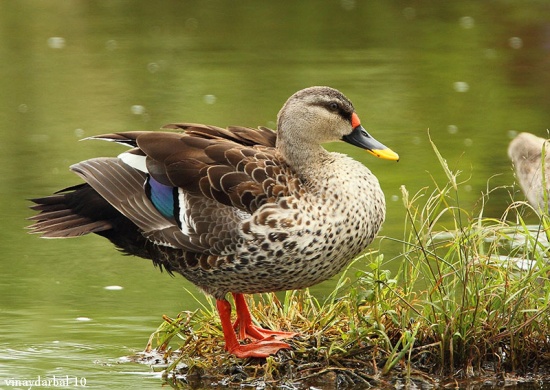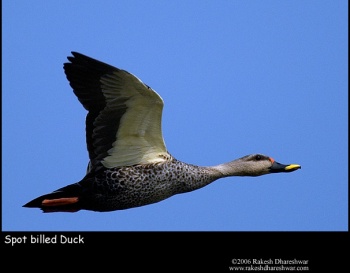- Anas poecilorhyncha
Identification
At 58-63 cm (23-25 in) slightly bigger than a Mallard.
The body is blackish and heavily scaled. The head is withish with a black cap and eyestripe. The terminal half of the inner tertial are white and the bill is black with a yellow tip. Males of the nominate subspecies and haringtoni have a variable red spot at the base of the bill, haringtoni a smaller one.
Shows a green speculum in flight.
Distribution
Found on the Indian Subcontinent (including Sri Lanka) and east to Burma, extreme south China and Laos.
Taxonomy
A dabbling duck of the genus Anas. Forms a superspecies with Eastern Spot-billed Duck, Pacific Black Duck and Philippine Duck.
Was formerly considered conspecific with Eastern Spot-billed Duck.
Subspecies
There are two subspecies[1]:
- A.p. haringtoni in East Assam, Burma, South China and Laos
- A.p. poeciloryncha in the Indian Subcontinent.
Habitat
Various types of wetlands, at the coast and inland. Prefers shallow water with vegetation.
Behaviour
May move seasonally.
Breeding
Breeding season variable. Usually in single pairs but may form loose small colonies. Nests in a pad of vegetation on the ground or in trees, always near water. Lays 7-9 eggs.
Diet
Feeds vegetarian, mostly seeds, parts of grasses, sedges and aquatic vegetation. Only occasionally water insects are taken. Like other dabbling ducks this species feeds head-dipping and upending in the water.
Vocalisation
<flashmp3>indian_spot_billed_duck_alok.mp3</flashmp3>
Listen in an external program
Recording by Alok Tewari
Keoladeo National Park, India, Dec.-2016
Two individuals calling in succession.
References
- Clements, J. F., T. S. Schulenberg, M. J. Iliff, D. Roberson, T. A. Fredericks, B. L. Sullivan, and C. L. Wood. 2016. The eBird/Clements checklist of birds of the world: v2016, with updates to August 2016. Downloaded from http://www.birds.cornell.edu/clementschecklist/download/
Recommended Citation
- BirdForum Opus contributors. (2024) Indian Spot-billed Duck. In: BirdForum, the forum for wild birds and birding. Retrieved 27 April 2024 from https://www.birdforum.net/opus/Indian_Spot-billed_Duck
External Links





